Organisational Behaviour Report: Leadership, Culture, and Change
VerifiedAdded on 2021/02/18
|15
|3980
|132
Report
AI Summary
This report provides an in-depth analysis of organisational behaviour, focusing on leadership theories and their practical application. It examines various organisational structures, including divisional, functional, and matrix structures, and their characteristics. The report explores the impact of organisational culture, such as role, power, task, and person cultures, on employee effectiveness, specifically referencing the case of Robinsons & Co. Furthermore, it analyzes the impact of learning and teamwork on employee performance, highlighting the benefits of on-the-job training and collaborative work environments. The report also delves into different leadership styles, including democratic, autocratic, and situational leadership, and their effects on organisational outcomes. Finally, it discusses the process and outcomes of change management using Lewin's change model, emphasizing the importance of unfreezing, change implementation, and refreezing stages to enhance employee effectiveness. The report concludes with an overview of various leadership theories, such as contingency and situational theories, offering valuable insights into effective leadership practices within diverse business contexts.
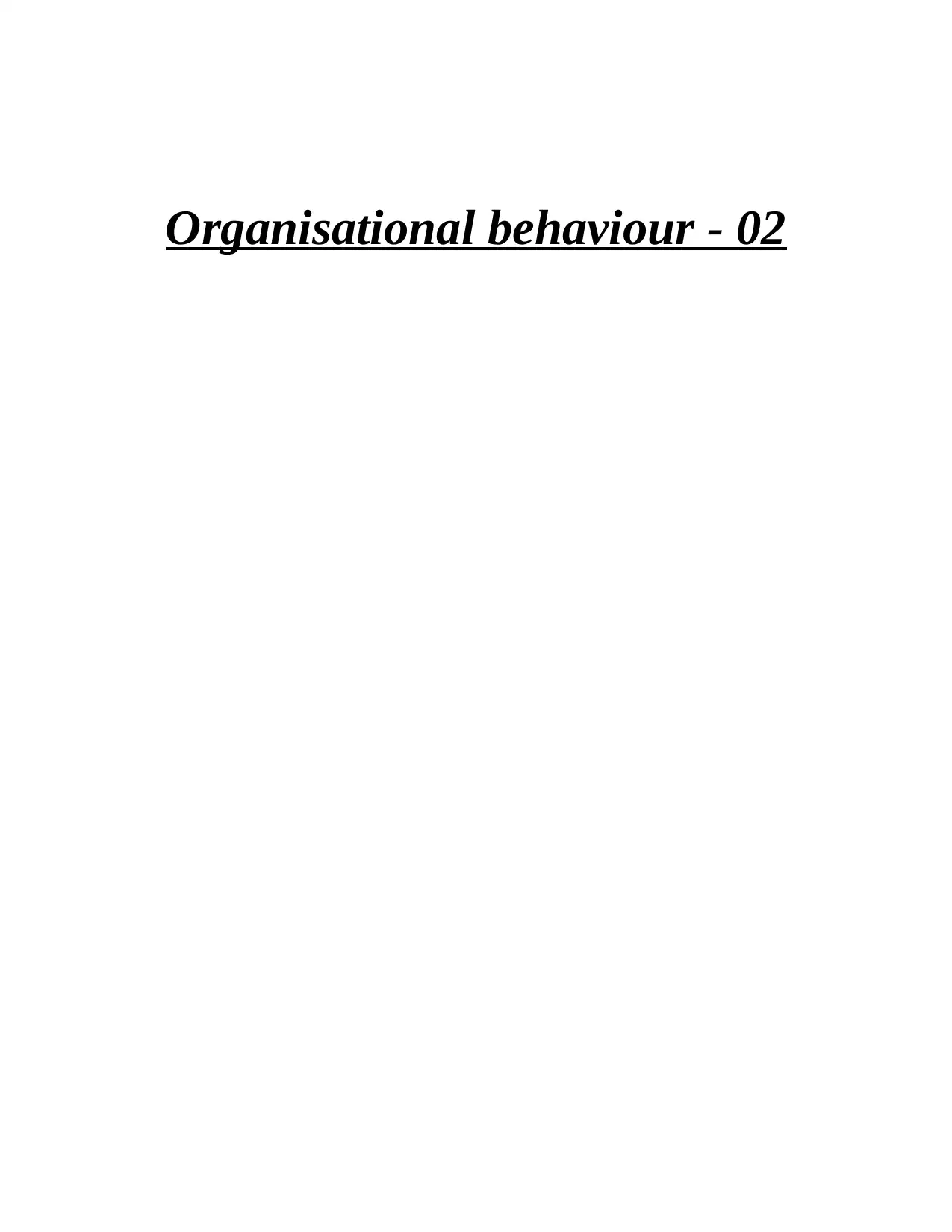
Organisational behaviour - 02
Paraphrase This Document
Need a fresh take? Get an instant paraphrase of this document with our AI Paraphraser
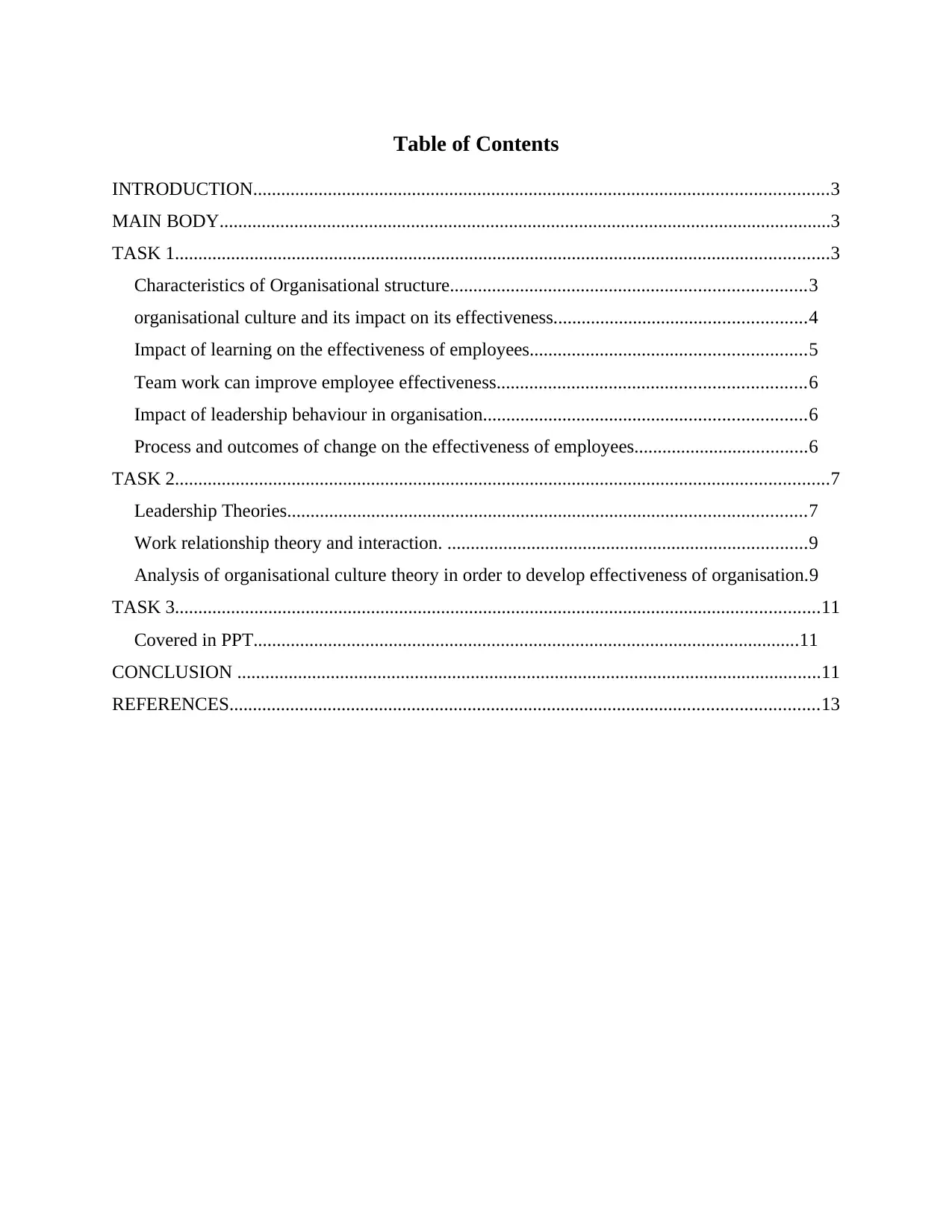
Table of Contents
INTRODUCTION...........................................................................................................................3
MAIN BODY...................................................................................................................................3
TASK 1............................................................................................................................................3
Characteristics of Organisational structure............................................................................3
organisational culture and its impact on its effectiveness......................................................4
Impact of learning on the effectiveness of employees...........................................................5
Team work can improve employee effectiveness..................................................................6
Impact of leadership behaviour in organisation.....................................................................6
Process and outcomes of change on the effectiveness of employees.....................................6
TASK 2............................................................................................................................................7
Leadership Theories...............................................................................................................7
Work relationship theory and interaction. .............................................................................9
Analysis of organisational culture theory in order to develop effectiveness of organisation.9
TASK 3..........................................................................................................................................11
Covered in PPT.....................................................................................................................11
CONCLUSION .............................................................................................................................11
REFERENCES..............................................................................................................................13
INTRODUCTION...........................................................................................................................3
MAIN BODY...................................................................................................................................3
TASK 1............................................................................................................................................3
Characteristics of Organisational structure............................................................................3
organisational culture and its impact on its effectiveness......................................................4
Impact of learning on the effectiveness of employees...........................................................5
Team work can improve employee effectiveness..................................................................6
Impact of leadership behaviour in organisation.....................................................................6
Process and outcomes of change on the effectiveness of employees.....................................6
TASK 2............................................................................................................................................7
Leadership Theories...............................................................................................................7
Work relationship theory and interaction. .............................................................................9
Analysis of organisational culture theory in order to develop effectiveness of organisation.9
TASK 3..........................................................................................................................................11
Covered in PPT.....................................................................................................................11
CONCLUSION .............................................................................................................................11
REFERENCES..............................................................................................................................13
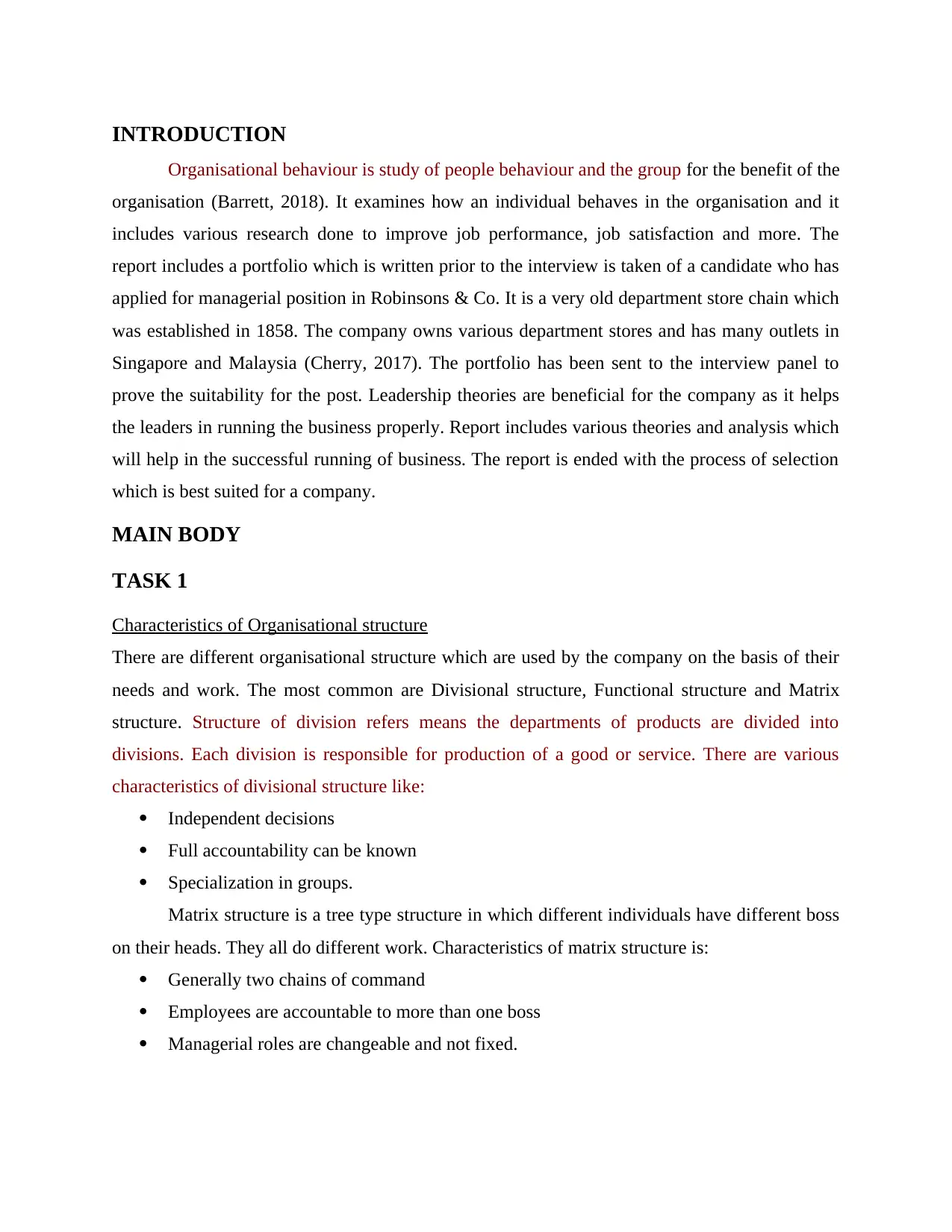
INTRODUCTION
Organisational behaviour is study of people behaviour and the group for the benefit of the
organisation (Barrett, 2018). It examines how an individual behaves in the organisation and it
includes various research done to improve job performance, job satisfaction and more. The
report includes a portfolio which is written prior to the interview is taken of a candidate who has
applied for managerial position in Robinsons & Co. It is a very old department store chain which
was established in 1858. The company owns various department stores and has many outlets in
Singapore and Malaysia (Cherry, 2017). The portfolio has been sent to the interview panel to
prove the suitability for the post. Leadership theories are beneficial for the company as it helps
the leaders in running the business properly. Report includes various theories and analysis which
will help in the successful running of business. The report is ended with the process of selection
which is best suited for a company.
MAIN BODY
TASK 1
Characteristics of Organisational structure
There are different organisational structure which are used by the company on the basis of their
needs and work. The most common are Divisional structure, Functional structure and Matrix
structure. Structure of division refers means the departments of products are divided into
divisions. Each division is responsible for production of a good or service. There are various
characteristics of divisional structure like:
Independent decisions
Full accountability can be known
Specialization in groups.
Matrix structure is a tree type structure in which different individuals have different boss
on their heads. They all do different work. Characteristics of matrix structure is:
Generally two chains of command
Employees are accountable to more than one boss
Managerial roles are changeable and not fixed.
Organisational behaviour is study of people behaviour and the group for the benefit of the
organisation (Barrett, 2018). It examines how an individual behaves in the organisation and it
includes various research done to improve job performance, job satisfaction and more. The
report includes a portfolio which is written prior to the interview is taken of a candidate who has
applied for managerial position in Robinsons & Co. It is a very old department store chain which
was established in 1858. The company owns various department stores and has many outlets in
Singapore and Malaysia (Cherry, 2017). The portfolio has been sent to the interview panel to
prove the suitability for the post. Leadership theories are beneficial for the company as it helps
the leaders in running the business properly. Report includes various theories and analysis which
will help in the successful running of business. The report is ended with the process of selection
which is best suited for a company.
MAIN BODY
TASK 1
Characteristics of Organisational structure
There are different organisational structure which are used by the company on the basis of their
needs and work. The most common are Divisional structure, Functional structure and Matrix
structure. Structure of division refers means the departments of products are divided into
divisions. Each division is responsible for production of a good or service. There are various
characteristics of divisional structure like:
Independent decisions
Full accountability can be known
Specialization in groups.
Matrix structure is a tree type structure in which different individuals have different boss
on their heads. They all do different work. Characteristics of matrix structure is:
Generally two chains of command
Employees are accountable to more than one boss
Managerial roles are changeable and not fixed.
⊘ This is a preview!⊘
Do you want full access?
Subscribe today to unlock all pages.

Trusted by 1+ million students worldwide
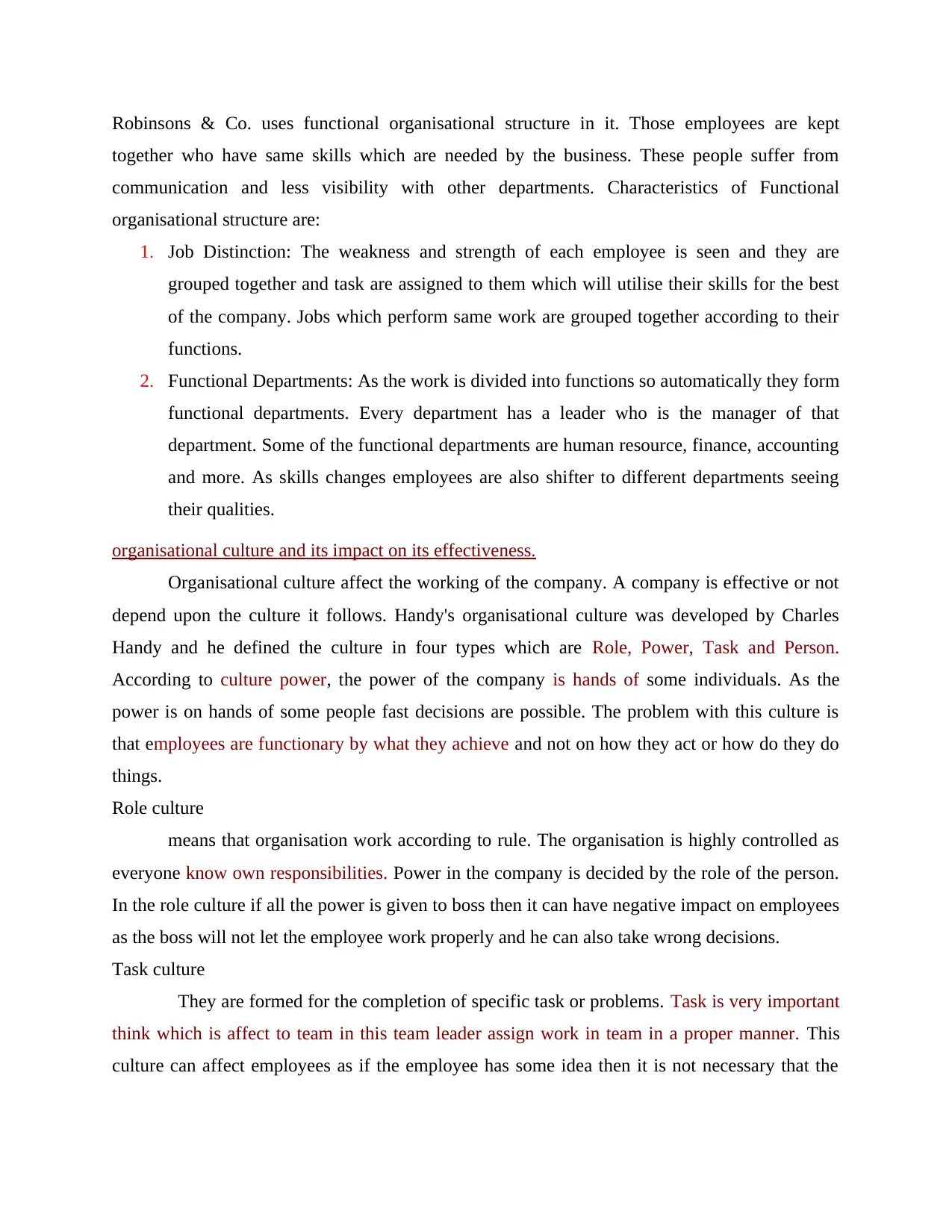
Robinsons & Co. uses functional organisational structure in it. Those employees are kept
together who have same skills which are needed by the business. These people suffer from
communication and less visibility with other departments. Characteristics of Functional
organisational structure are:
1. Job Distinction: The weakness and strength of each employee is seen and they are
grouped together and task are assigned to them which will utilise their skills for the best
of the company. Jobs which perform same work are grouped together according to their
functions.
2. Functional Departments: As the work is divided into functions so automatically they form
functional departments. Every department has a leader who is the manager of that
department. Some of the functional departments are human resource, finance, accounting
and more. As skills changes employees are also shifter to different departments seeing
their qualities.
organisational culture and its impact on its effectiveness.
Organisational culture affect the working of the company. A company is effective or not
depend upon the culture it follows. Handy's organisational culture was developed by Charles
Handy and he defined the culture in four types which are Role, Power, Task and Person.
According to culture power, the power of the company is hands of some individuals. As the
power is on hands of some people fast decisions are possible. The problem with this culture is
that employees are functionary by what they achieve and not on how they act or how do they do
things.
Role culture
means that organisation work according to rule. The organisation is highly controlled as
everyone know own responsibilities. Power in the company is decided by the role of the person.
In the role culture if all the power is given to boss then it can have negative impact on employees
as the boss will not let the employee work properly and he can also take wrong decisions.
Task culture
They are formed for the completion of specific task or problems. Task is very important
think which is affect to team in this team leader assign work in team in a proper manner. This
culture can affect employees as if the employee has some idea then it is not necessary that the
together who have same skills which are needed by the business. These people suffer from
communication and less visibility with other departments. Characteristics of Functional
organisational structure are:
1. Job Distinction: The weakness and strength of each employee is seen and they are
grouped together and task are assigned to them which will utilise their skills for the best
of the company. Jobs which perform same work are grouped together according to their
functions.
2. Functional Departments: As the work is divided into functions so automatically they form
functional departments. Every department has a leader who is the manager of that
department. Some of the functional departments are human resource, finance, accounting
and more. As skills changes employees are also shifter to different departments seeing
their qualities.
organisational culture and its impact on its effectiveness.
Organisational culture affect the working of the company. A company is effective or not
depend upon the culture it follows. Handy's organisational culture was developed by Charles
Handy and he defined the culture in four types which are Role, Power, Task and Person.
According to culture power, the power of the company is hands of some individuals. As the
power is on hands of some people fast decisions are possible. The problem with this culture is
that employees are functionary by what they achieve and not on how they act or how do they do
things.
Role culture
means that organisation work according to rule. The organisation is highly controlled as
everyone know own responsibilities. Power in the company is decided by the role of the person.
In the role culture if all the power is given to boss then it can have negative impact on employees
as the boss will not let the employee work properly and he can also take wrong decisions.
Task culture
They are formed for the completion of specific task or problems. Task is very important
think which is affect to team in this team leader assign work in team in a proper manner. This
culture can affect employees as if the employee has some idea then it is not necessary that the
Paraphrase This Document
Need a fresh take? Get an instant paraphrase of this document with our AI Paraphraser
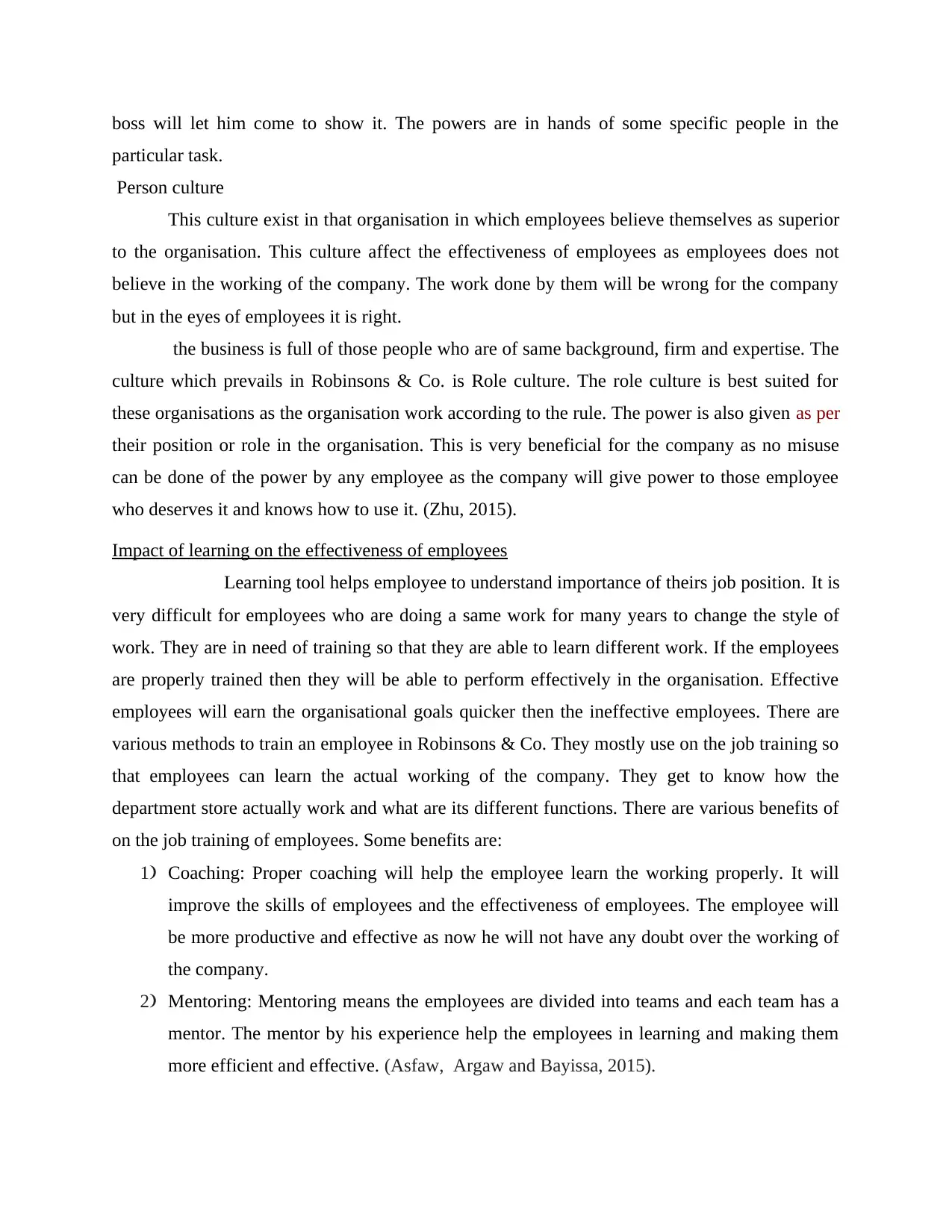
boss will let him come to show it. The powers are in hands of some specific people in the
particular task.
Person culture
This culture exist in that organisation in which employees believe themselves as superior
to the organisation. This culture affect the effectiveness of employees as employees does not
believe in the working of the company. The work done by them will be wrong for the company
but in the eyes of employees it is right.
the business is full of those people who are of same background, firm and expertise. The
culture which prevails in Robinsons & Co. is Role culture. The role culture is best suited for
these organisations as the organisation work according to the rule. The power is also given as per
their position or role in the organisation. This is very beneficial for the company as no misuse
can be done of the power by any employee as the company will give power to those employee
who deserves it and knows how to use it. (Zhu, 2015).
Impact of learning on the effectiveness of employees
Learning tool helps employee to understand importance of theirs job position. It is
very difficult for employees who are doing a same work for many years to change the style of
work. They are in need of training so that they are able to learn different work. If the employees
are properly trained then they will be able to perform effectively in the organisation. Effective
employees will earn the organisational goals quicker then the ineffective employees. There are
various methods to train an employee in Robinsons & Co. They mostly use on the job training so
that employees can learn the actual working of the company. They get to know how the
department store actually work and what are its different functions. There are various benefits of
on the job training of employees. Some benefits are:
1) Coaching: Proper coaching will help the employee learn the working properly. It will
improve the skills of employees and the effectiveness of employees. The employee will
be more productive and effective as now he will not have any doubt over the working of
the company.
2) Mentoring: Mentoring means the employees are divided into teams and each team has a
mentor. The mentor by his experience help the employees in learning and making them
more efficient and effective. (Asfaw, Argaw and Bayissa, 2015).
particular task.
Person culture
This culture exist in that organisation in which employees believe themselves as superior
to the organisation. This culture affect the effectiveness of employees as employees does not
believe in the working of the company. The work done by them will be wrong for the company
but in the eyes of employees it is right.
the business is full of those people who are of same background, firm and expertise. The
culture which prevails in Robinsons & Co. is Role culture. The role culture is best suited for
these organisations as the organisation work according to the rule. The power is also given as per
their position or role in the organisation. This is very beneficial for the company as no misuse
can be done of the power by any employee as the company will give power to those employee
who deserves it and knows how to use it. (Zhu, 2015).
Impact of learning on the effectiveness of employees
Learning tool helps employee to understand importance of theirs job position. It is
very difficult for employees who are doing a same work for many years to change the style of
work. They are in need of training so that they are able to learn different work. If the employees
are properly trained then they will be able to perform effectively in the organisation. Effective
employees will earn the organisational goals quicker then the ineffective employees. There are
various methods to train an employee in Robinsons & Co. They mostly use on the job training so
that employees can learn the actual working of the company. They get to know how the
department store actually work and what are its different functions. There are various benefits of
on the job training of employees. Some benefits are:
1) Coaching: Proper coaching will help the employee learn the working properly. It will
improve the skills of employees and the effectiveness of employees. The employee will
be more productive and effective as now he will not have any doubt over the working of
the company.
2) Mentoring: Mentoring means the employees are divided into teams and each team has a
mentor. The mentor by his experience help the employees in learning and making them
more efficient and effective. (Asfaw, Argaw and Bayissa, 2015).
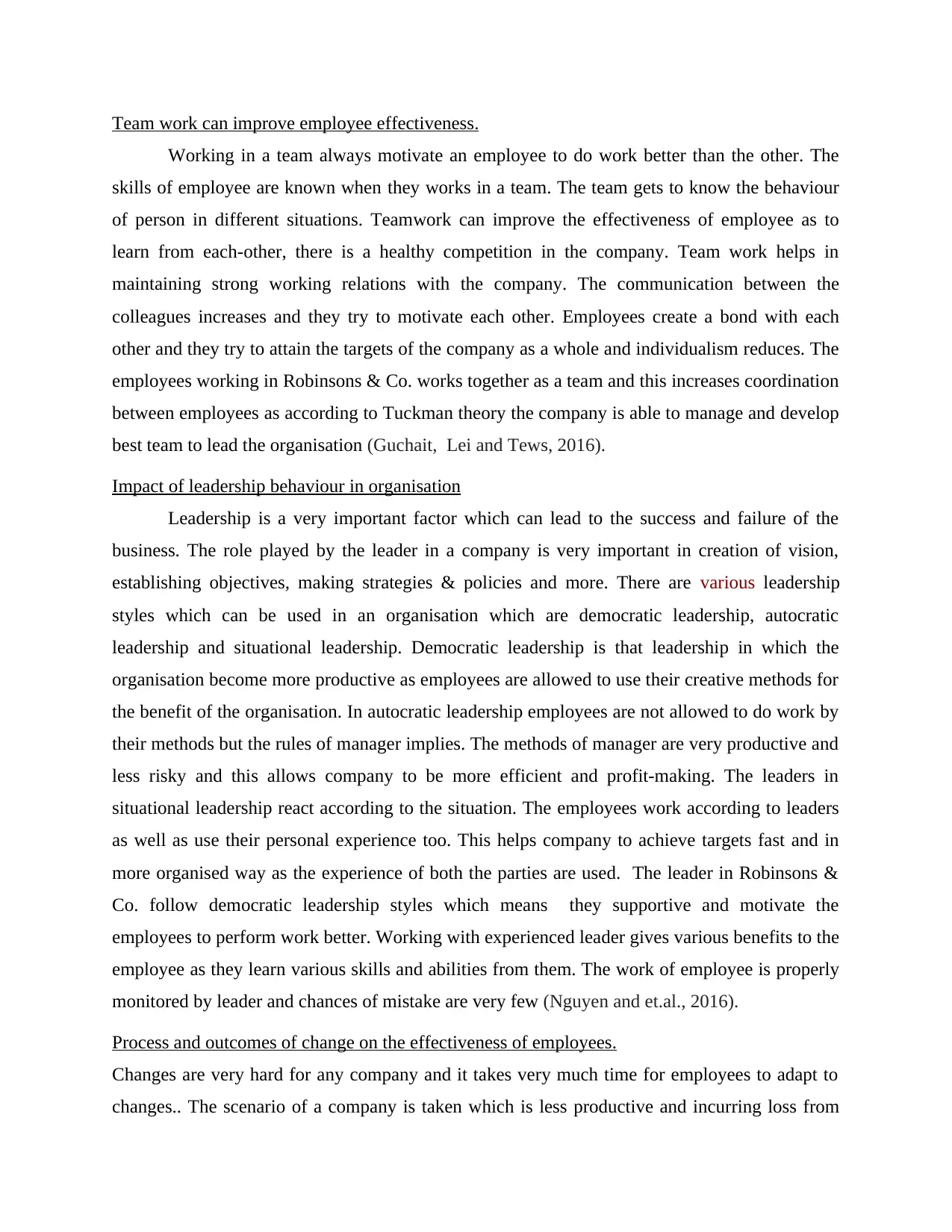
Team work can improve employee effectiveness.
Working in a team always motivate an employee to do work better than the other. The
skills of employee are known when they works in a team. The team gets to know the behaviour
of person in different situations. Teamwork can improve the effectiveness of employee as to
learn from each-other, there is a healthy competition in the company. Team work helps in
maintaining strong working relations with the company. The communication between the
colleagues increases and they try to motivate each other. Employees create a bond with each
other and they try to attain the targets of the company as a whole and individualism reduces. The
employees working in Robinsons & Co. works together as a team and this increases coordination
between employees as according to Tuckman theory the company is able to manage and develop
best team to lead the organisation (Guchait, Lei and Tews, 2016).
Impact of leadership behaviour in organisation
Leadership is a very important factor which can lead to the success and failure of the
business. The role played by the leader in a company is very important in creation of vision,
establishing objectives, making strategies & policies and more. There are various leadership
styles which can be used in an organisation which are democratic leadership, autocratic
leadership and situational leadership. Democratic leadership is that leadership in which the
organisation become more productive as employees are allowed to use their creative methods for
the benefit of the organisation. In autocratic leadership employees are not allowed to do work by
their methods but the rules of manager implies. The methods of manager are very productive and
less risky and this allows company to be more efficient and profit-making. The leaders in
situational leadership react according to the situation. The employees work according to leaders
as well as use their personal experience too. This helps company to achieve targets fast and in
more organised way as the experience of both the parties are used. The leader in Robinsons &
Co. follow democratic leadership styles which means they supportive and motivate the
employees to perform work better. Working with experienced leader gives various benefits to the
employee as they learn various skills and abilities from them. The work of employee is properly
monitored by leader and chances of mistake are very few (Nguyen and et.al., 2016).
Process and outcomes of change on the effectiveness of employees.
Changes are very hard for any company and it takes very much time for employees to adapt to
changes.. The scenario of a company is taken which is less productive and incurring loss from
Working in a team always motivate an employee to do work better than the other. The
skills of employee are known when they works in a team. The team gets to know the behaviour
of person in different situations. Teamwork can improve the effectiveness of employee as to
learn from each-other, there is a healthy competition in the company. Team work helps in
maintaining strong working relations with the company. The communication between the
colleagues increases and they try to motivate each other. Employees create a bond with each
other and they try to attain the targets of the company as a whole and individualism reduces. The
employees working in Robinsons & Co. works together as a team and this increases coordination
between employees as according to Tuckman theory the company is able to manage and develop
best team to lead the organisation (Guchait, Lei and Tews, 2016).
Impact of leadership behaviour in organisation
Leadership is a very important factor which can lead to the success and failure of the
business. The role played by the leader in a company is very important in creation of vision,
establishing objectives, making strategies & policies and more. There are various leadership
styles which can be used in an organisation which are democratic leadership, autocratic
leadership and situational leadership. Democratic leadership is that leadership in which the
organisation become more productive as employees are allowed to use their creative methods for
the benefit of the organisation. In autocratic leadership employees are not allowed to do work by
their methods but the rules of manager implies. The methods of manager are very productive and
less risky and this allows company to be more efficient and profit-making. The leaders in
situational leadership react according to the situation. The employees work according to leaders
as well as use their personal experience too. This helps company to achieve targets fast and in
more organised way as the experience of both the parties are used. The leader in Robinsons &
Co. follow democratic leadership styles which means they supportive and motivate the
employees to perform work better. Working with experienced leader gives various benefits to the
employee as they learn various skills and abilities from them. The work of employee is properly
monitored by leader and chances of mistake are very few (Nguyen and et.al., 2016).
Process and outcomes of change on the effectiveness of employees.
Changes are very hard for any company and it takes very much time for employees to adapt to
changes.. The scenario of a company is taken which is less productive and incurring loss from
⊘ This is a preview!⊘
Do you want full access?
Subscribe today to unlock all pages.

Trusted by 1+ million students worldwide
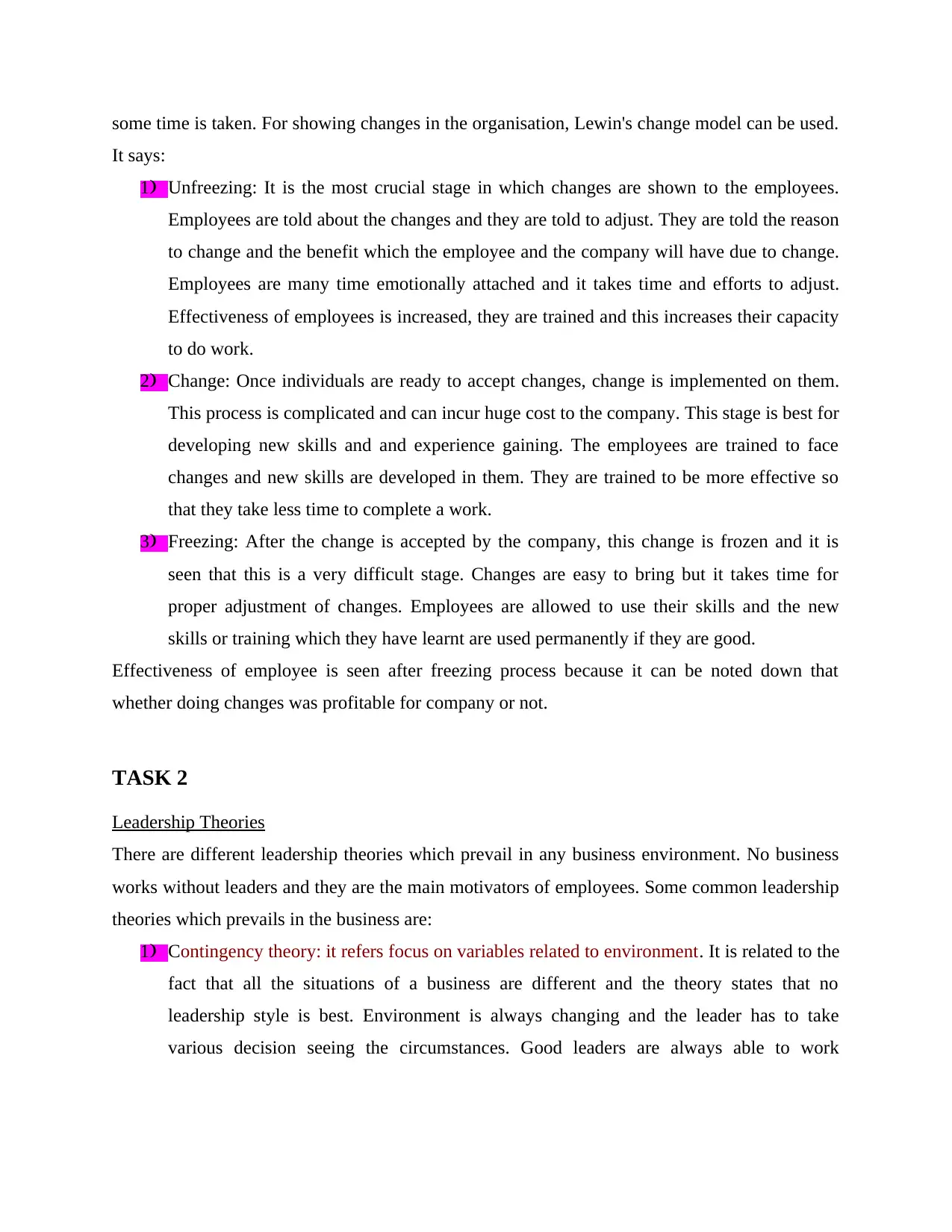
some time is taken. For showing changes in the organisation, Lewin's change model can be used.
It says:
1) Unfreezing: It is the most crucial stage in which changes are shown to the employees.
Employees are told about the changes and they are told to adjust. They are told the reason
to change and the benefit which the employee and the company will have due to change.
Employees are many time emotionally attached and it takes time and efforts to adjust.
Effectiveness of employees is increased, they are trained and this increases their capacity
to do work.
2) Change: Once individuals are ready to accept changes, change is implemented on them.
This process is complicated and can incur huge cost to the company. This stage is best for
developing new skills and and experience gaining. The employees are trained to face
changes and new skills are developed in them. They are trained to be more effective so
that they take less time to complete a work.
3) Freezing: After the change is accepted by the company, this change is frozen and it is
seen that this is a very difficult stage. Changes are easy to bring but it takes time for
proper adjustment of changes. Employees are allowed to use their skills and the new
skills or training which they have learnt are used permanently if they are good.
Effectiveness of employee is seen after freezing process because it can be noted down that
whether doing changes was profitable for company or not.
TASK 2
Leadership Theories
There are different leadership theories which prevail in any business environment. No business
works without leaders and they are the main motivators of employees. Some common leadership
theories which prevails in the business are:
1) Contingency theory: it refers focus on variables related to environment. It is related to the
fact that all the situations of a business are different and the theory states that no
leadership style is best. Environment is always changing and the leader has to take
various decision seeing the circumstances. Good leaders are always able to work
It says:
1) Unfreezing: It is the most crucial stage in which changes are shown to the employees.
Employees are told about the changes and they are told to adjust. They are told the reason
to change and the benefit which the employee and the company will have due to change.
Employees are many time emotionally attached and it takes time and efforts to adjust.
Effectiveness of employees is increased, they are trained and this increases their capacity
to do work.
2) Change: Once individuals are ready to accept changes, change is implemented on them.
This process is complicated and can incur huge cost to the company. This stage is best for
developing new skills and and experience gaining. The employees are trained to face
changes and new skills are developed in them. They are trained to be more effective so
that they take less time to complete a work.
3) Freezing: After the change is accepted by the company, this change is frozen and it is
seen that this is a very difficult stage. Changes are easy to bring but it takes time for
proper adjustment of changes. Employees are allowed to use their skills and the new
skills or training which they have learnt are used permanently if they are good.
Effectiveness of employee is seen after freezing process because it can be noted down that
whether doing changes was profitable for company or not.
TASK 2
Leadership Theories
There are different leadership theories which prevail in any business environment. No business
works without leaders and they are the main motivators of employees. Some common leadership
theories which prevails in the business are:
1) Contingency theory: it refers focus on variables related to environment. It is related to the
fact that all the situations of a business are different and the theory states that no
leadership style is best. Environment is always changing and the leader has to take
various decision seeing the circumstances. Good leaders are always able to work
Paraphrase This Document
Need a fresh take? Get an instant paraphrase of this document with our AI Paraphraser
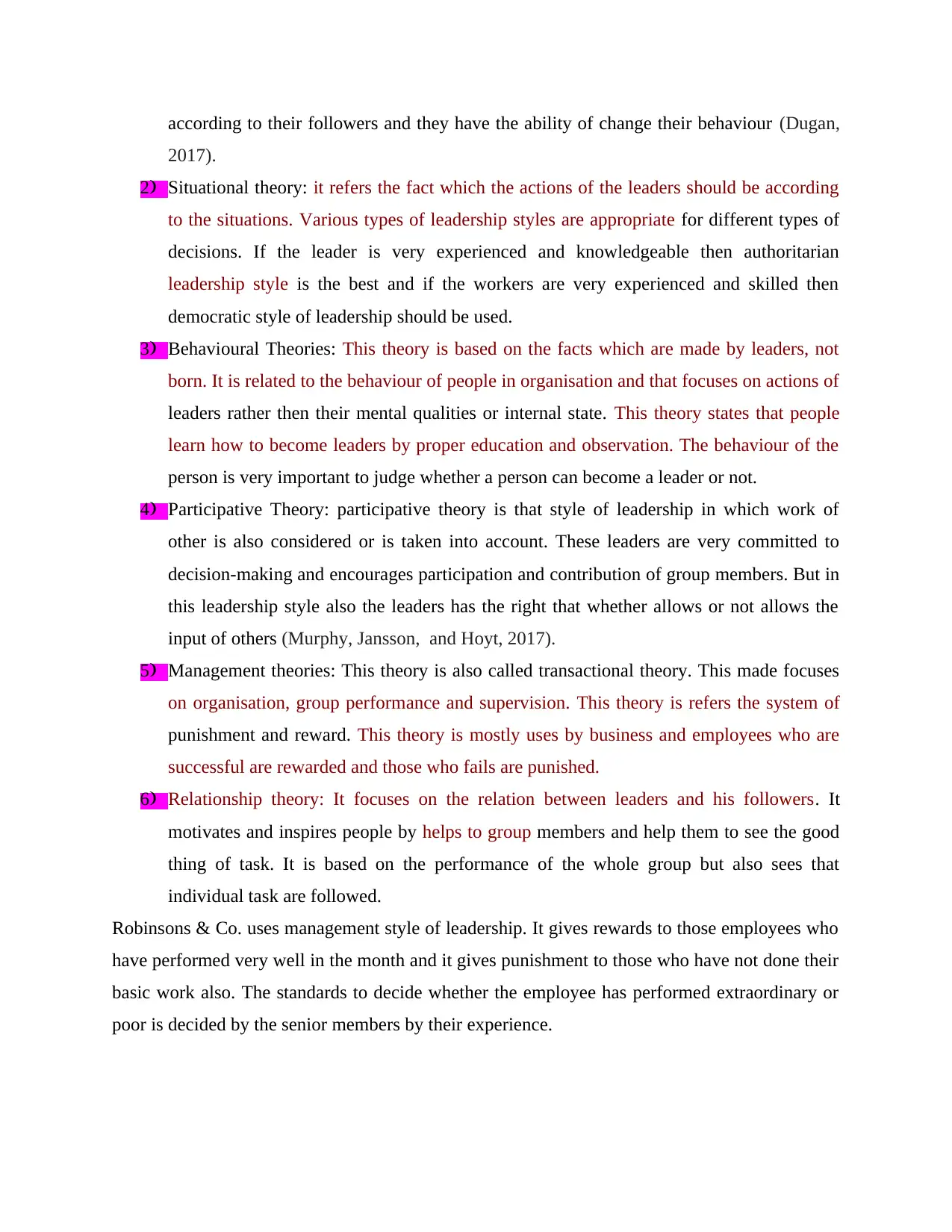
according to their followers and they have the ability of change their behaviour (Dugan,
2017).
2) Situational theory: it refers the fact which the actions of the leaders should be according
to the situations. Various types of leadership styles are appropriate for different types of
decisions. If the leader is very experienced and knowledgeable then authoritarian
leadership style is the best and if the workers are very experienced and skilled then
democratic style of leadership should be used.
3) Behavioural Theories: This theory is based on the facts which are made by leaders, not
born. It is related to the behaviour of people in organisation and that focuses on actions of
leaders rather then their mental qualities or internal state. This theory states that people
learn how to become leaders by proper education and observation. The behaviour of the
person is very important to judge whether a person can become a leader or not.
4) Participative Theory: participative theory is that style of leadership in which work of
other is also considered or is taken into account. These leaders are very committed to
decision-making and encourages participation and contribution of group members. But in
this leadership style also the leaders has the right that whether allows or not allows the
input of others (Murphy, Jansson, and Hoyt, 2017).
5) Management theories: This theory is also called transactional theory. This made focuses
on organisation, group performance and supervision. This theory is refers the system of
punishment and reward. This theory is mostly uses by business and employees who are
successful are rewarded and those who fails are punished.
6) Relationship theory: It focuses on the relation between leaders and his followers. It
motivates and inspires people by helps to group members and help them to see the good
thing of task. It is based on the performance of the whole group but also sees that
individual task are followed.
Robinsons & Co. uses management style of leadership. It gives rewards to those employees who
have performed very well in the month and it gives punishment to those who have not done their
basic work also. The standards to decide whether the employee has performed extraordinary or
poor is decided by the senior members by their experience.
2017).
2) Situational theory: it refers the fact which the actions of the leaders should be according
to the situations. Various types of leadership styles are appropriate for different types of
decisions. If the leader is very experienced and knowledgeable then authoritarian
leadership style is the best and if the workers are very experienced and skilled then
democratic style of leadership should be used.
3) Behavioural Theories: This theory is based on the facts which are made by leaders, not
born. It is related to the behaviour of people in organisation and that focuses on actions of
leaders rather then their mental qualities or internal state. This theory states that people
learn how to become leaders by proper education and observation. The behaviour of the
person is very important to judge whether a person can become a leader or not.
4) Participative Theory: participative theory is that style of leadership in which work of
other is also considered or is taken into account. These leaders are very committed to
decision-making and encourages participation and contribution of group members. But in
this leadership style also the leaders has the right that whether allows or not allows the
input of others (Murphy, Jansson, and Hoyt, 2017).
5) Management theories: This theory is also called transactional theory. This made focuses
on organisation, group performance and supervision. This theory is refers the system of
punishment and reward. This theory is mostly uses by business and employees who are
successful are rewarded and those who fails are punished.
6) Relationship theory: It focuses on the relation between leaders and his followers. It
motivates and inspires people by helps to group members and help them to see the good
thing of task. It is based on the performance of the whole group but also sees that
individual task are followed.
Robinsons & Co. uses management style of leadership. It gives rewards to those employees who
have performed very well in the month and it gives punishment to those who have not done their
basic work also. The standards to decide whether the employee has performed extraordinary or
poor is decided by the senior members by their experience.
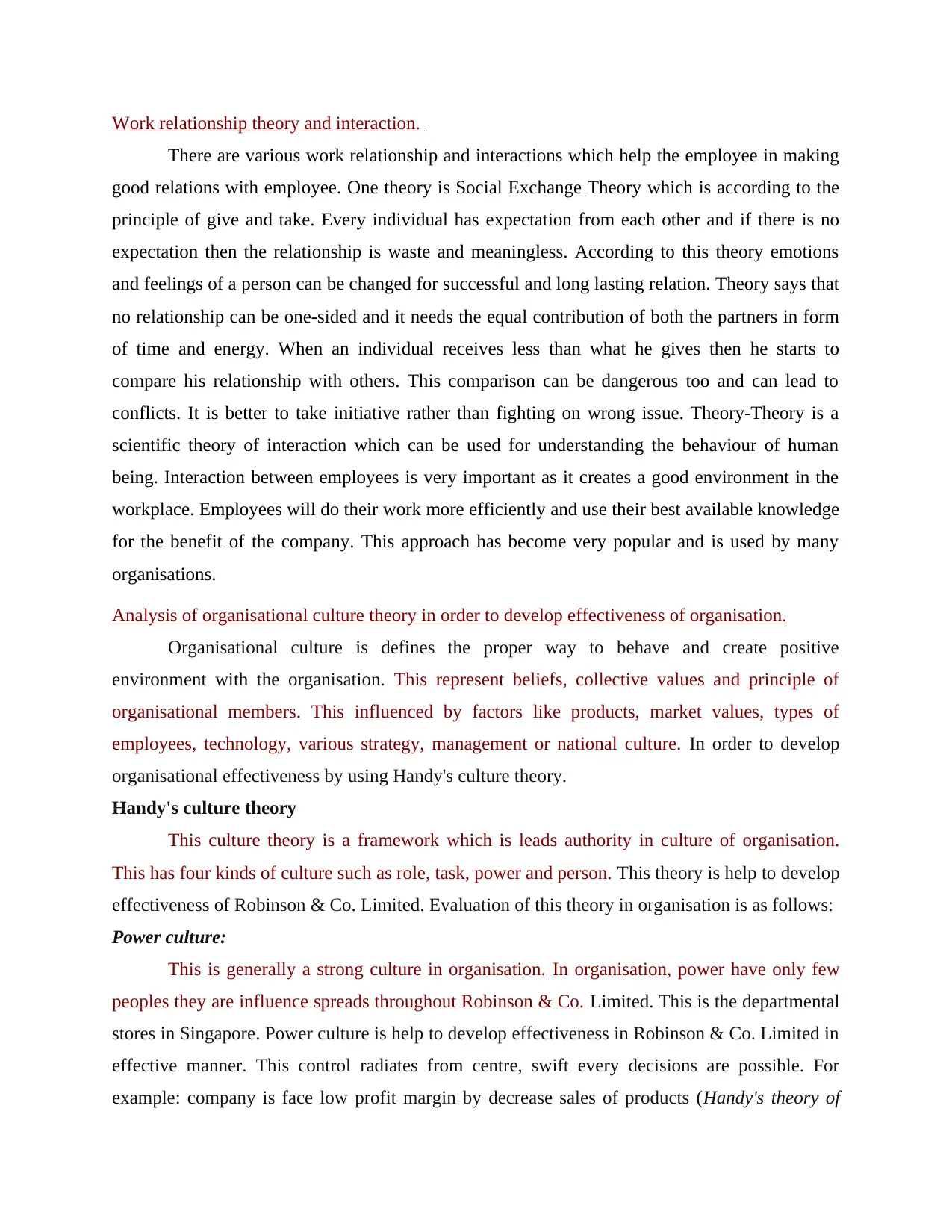
Work relationship theory and interaction.
There are various work relationship and interactions which help the employee in making
good relations with employee. One theory is Social Exchange Theory which is according to the
principle of give and take. Every individual has expectation from each other and if there is no
expectation then the relationship is waste and meaningless. According to this theory emotions
and feelings of a person can be changed for successful and long lasting relation. Theory says that
no relationship can be one-sided and it needs the equal contribution of both the partners in form
of time and energy. When an individual receives less than what he gives then he starts to
compare his relationship with others. This comparison can be dangerous too and can lead to
conflicts. It is better to take initiative rather than fighting on wrong issue. Theory-Theory is a
scientific theory of interaction which can be used for understanding the behaviour of human
being. Interaction between employees is very important as it creates a good environment in the
workplace. Employees will do their work more efficiently and use their best available knowledge
for the benefit of the company. This approach has become very popular and is used by many
organisations.
Analysis of organisational culture theory in order to develop effectiveness of organisation.
Organisational culture is defines the proper way to behave and create positive
environment with the organisation. This represent beliefs, collective values and principle of
organisational members. This influenced by factors like products, market values, types of
employees, technology, various strategy, management or national culture. In order to develop
organisational effectiveness by using Handy's culture theory.
Handy's culture theory
This culture theory is a framework which is leads authority in culture of organisation.
This has four kinds of culture such as role, task, power and person. This theory is help to develop
effectiveness of Robinson & Co. Limited. Evaluation of this theory in organisation is as follows:
Power culture:
This is generally a strong culture in organisation. In organisation, power have only few
peoples they are influence spreads throughout Robinson & Co. Limited. This is the departmental
stores in Singapore. Power culture is help to develop effectiveness in Robinson & Co. Limited in
effective manner. This control radiates from centre, swift every decisions are possible. For
example: company is face low profit margin by decrease sales of products (Handy's theory of
There are various work relationship and interactions which help the employee in making
good relations with employee. One theory is Social Exchange Theory which is according to the
principle of give and take. Every individual has expectation from each other and if there is no
expectation then the relationship is waste and meaningless. According to this theory emotions
and feelings of a person can be changed for successful and long lasting relation. Theory says that
no relationship can be one-sided and it needs the equal contribution of both the partners in form
of time and energy. When an individual receives less than what he gives then he starts to
compare his relationship with others. This comparison can be dangerous too and can lead to
conflicts. It is better to take initiative rather than fighting on wrong issue. Theory-Theory is a
scientific theory of interaction which can be used for understanding the behaviour of human
being. Interaction between employees is very important as it creates a good environment in the
workplace. Employees will do their work more efficiently and use their best available knowledge
for the benefit of the company. This approach has become very popular and is used by many
organisations.
Analysis of organisational culture theory in order to develop effectiveness of organisation.
Organisational culture is defines the proper way to behave and create positive
environment with the organisation. This represent beliefs, collective values and principle of
organisational members. This influenced by factors like products, market values, types of
employees, technology, various strategy, management or national culture. In order to develop
organisational effectiveness by using Handy's culture theory.
Handy's culture theory
This culture theory is a framework which is leads authority in culture of organisation.
This has four kinds of culture such as role, task, power and person. This theory is help to develop
effectiveness of Robinson & Co. Limited. Evaluation of this theory in organisation is as follows:
Power culture:
This is generally a strong culture in organisation. In organisation, power have only few
peoples they are influence spreads throughout Robinson & Co. Limited. This is the departmental
stores in Singapore. Power culture is help to develop effectiveness in Robinson & Co. Limited in
effective manner. This control radiates from centre, swift every decisions are possible. For
example: company is face low profit margin by decrease sales of products (Handy's theory of
⊘ This is a preview!⊘
Do you want full access?
Subscribe today to unlock all pages.

Trusted by 1+ million students worldwide
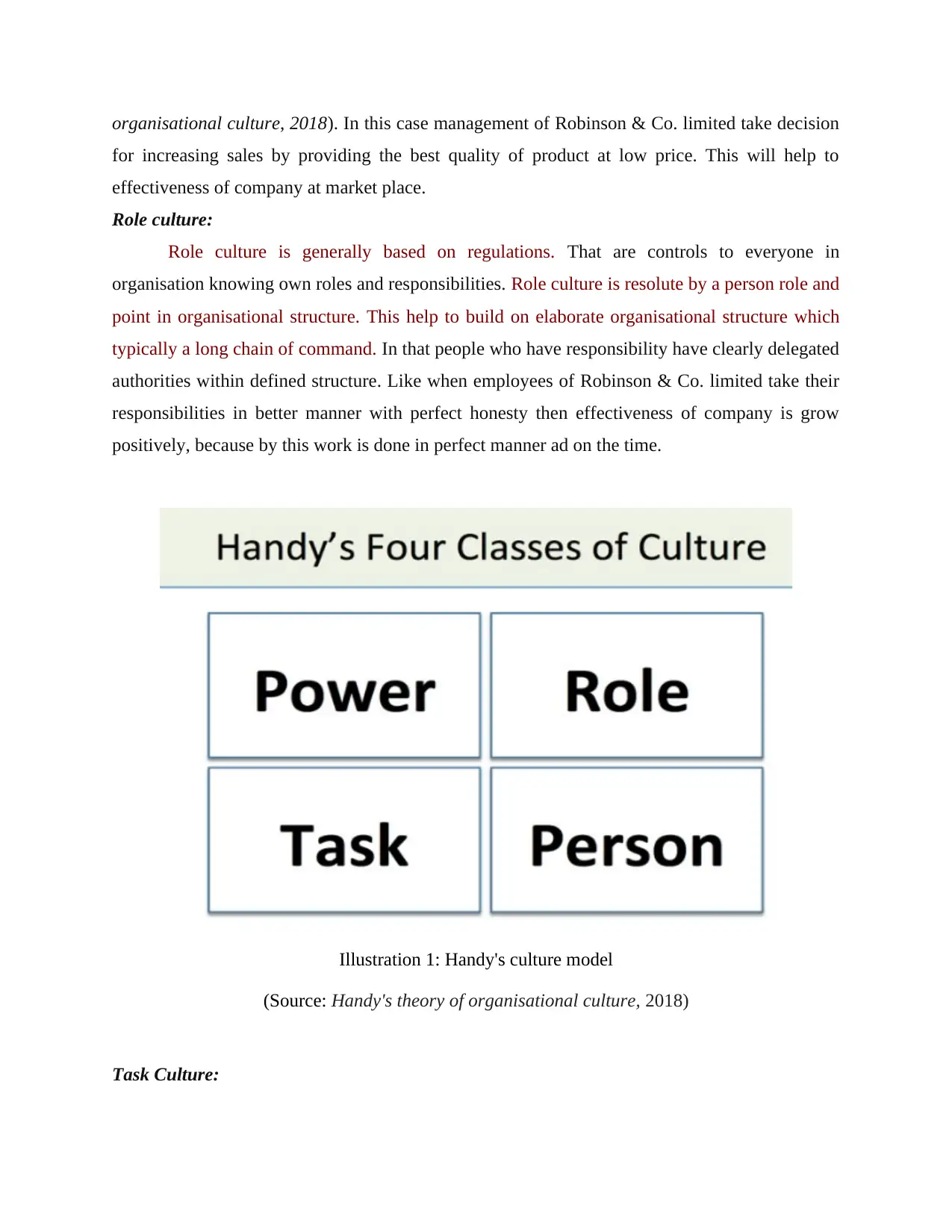
organisational culture, 2018). In this case management of Robinson & Co. limited take decision
for increasing sales by providing the best quality of product at low price. This will help to
effectiveness of company at market place.
Role culture:
Role culture is generally based on regulations. That are controls to everyone in
organisation knowing own roles and responsibilities. Role culture is resolute by a person role and
point in organisational structure. This help to build on elaborate organisational structure which
typically a long chain of command. In that people who have responsibility have clearly delegated
authorities within defined structure. Like when employees of Robinson & Co. limited take their
responsibilities in better manner with perfect honesty then effectiveness of company is grow
positively, because by this work is done in perfect manner ad on the time.
Task Culture:
Illustration 1: Handy's culture model
(Source: Handy's theory of organisational culture, 2018)
for increasing sales by providing the best quality of product at low price. This will help to
effectiveness of company at market place.
Role culture:
Role culture is generally based on regulations. That are controls to everyone in
organisation knowing own roles and responsibilities. Role culture is resolute by a person role and
point in organisational structure. This help to build on elaborate organisational structure which
typically a long chain of command. In that people who have responsibility have clearly delegated
authorities within defined structure. Like when employees of Robinson & Co. limited take their
responsibilities in better manner with perfect honesty then effectiveness of company is grow
positively, because by this work is done in perfect manner ad on the time.
Task Culture:
Illustration 1: Handy's culture model
(Source: Handy's theory of organisational culture, 2018)
Paraphrase This Document
Need a fresh take? Get an instant paraphrase of this document with our AI Paraphraser
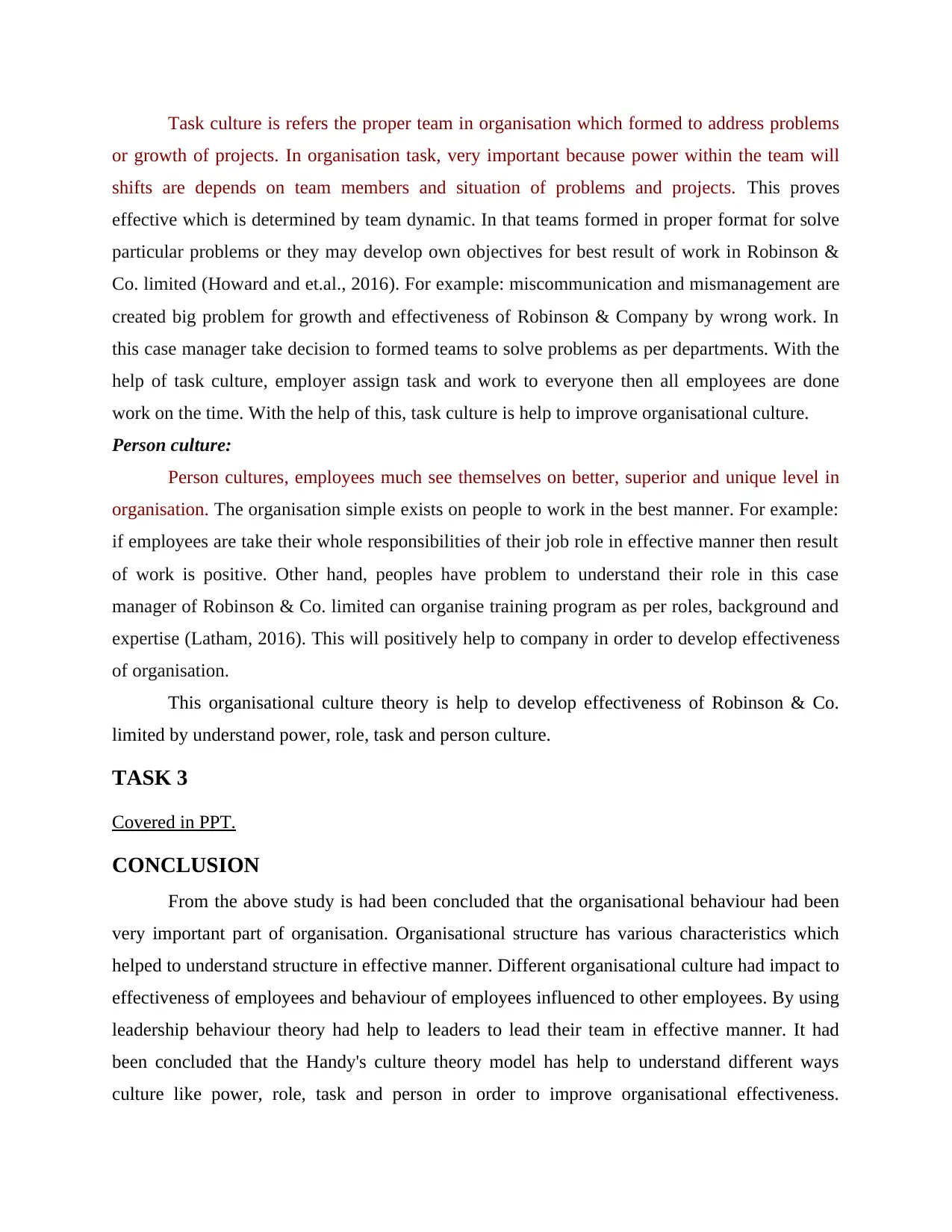
Task culture is refers the proper team in organisation which formed to address problems
or growth of projects. In organisation task, very important because power within the team will
shifts are depends on team members and situation of problems and projects. This proves
effective which is determined by team dynamic. In that teams formed in proper format for solve
particular problems or they may develop own objectives for best result of work in Robinson &
Co. limited (Howard and et.al., 2016). For example: miscommunication and mismanagement are
created big problem for growth and effectiveness of Robinson & Company by wrong work. In
this case manager take decision to formed teams to solve problems as per departments. With the
help of task culture, employer assign task and work to everyone then all employees are done
work on the time. With the help of this, task culture is help to improve organisational culture.
Person culture:
Person cultures, employees much see themselves on better, superior and unique level in
organisation. The organisation simple exists on people to work in the best manner. For example:
if employees are take their whole responsibilities of their job role in effective manner then result
of work is positive. Other hand, peoples have problem to understand their role in this case
manager of Robinson & Co. limited can organise training program as per roles, background and
expertise (Latham, 2016). This will positively help to company in order to develop effectiveness
of organisation.
This organisational culture theory is help to develop effectiveness of Robinson & Co.
limited by understand power, role, task and person culture.
TASK 3
Covered in PPT.
CONCLUSION
From the above study is had been concluded that the organisational behaviour had been
very important part of organisation. Organisational structure has various characteristics which
helped to understand structure in effective manner. Different organisational culture had impact to
effectiveness of employees and behaviour of employees influenced to other employees. By using
leadership behaviour theory had help to leaders to lead their team in effective manner. It had
been concluded that the Handy's culture theory model has help to understand different ways
culture like power, role, task and person in order to improve organisational effectiveness.
or growth of projects. In organisation task, very important because power within the team will
shifts are depends on team members and situation of problems and projects. This proves
effective which is determined by team dynamic. In that teams formed in proper format for solve
particular problems or they may develop own objectives for best result of work in Robinson &
Co. limited (Howard and et.al., 2016). For example: miscommunication and mismanagement are
created big problem for growth and effectiveness of Robinson & Company by wrong work. In
this case manager take decision to formed teams to solve problems as per departments. With the
help of task culture, employer assign task and work to everyone then all employees are done
work on the time. With the help of this, task culture is help to improve organisational culture.
Person culture:
Person cultures, employees much see themselves on better, superior and unique level in
organisation. The organisation simple exists on people to work in the best manner. For example:
if employees are take their whole responsibilities of their job role in effective manner then result
of work is positive. Other hand, peoples have problem to understand their role in this case
manager of Robinson & Co. limited can organise training program as per roles, background and
expertise (Latham, 2016). This will positively help to company in order to develop effectiveness
of organisation.
This organisational culture theory is help to develop effectiveness of Robinson & Co.
limited by understand power, role, task and person culture.
TASK 3
Covered in PPT.
CONCLUSION
From the above study is had been concluded that the organisational behaviour had been
very important part of organisation. Organisational structure has various characteristics which
helped to understand structure in effective manner. Different organisational culture had impact to
effectiveness of employees and behaviour of employees influenced to other employees. By using
leadership behaviour theory had help to leaders to lead their team in effective manner. It had
been concluded that the Handy's culture theory model has help to understand different ways
culture like power, role, task and person in order to improve organisational effectiveness.
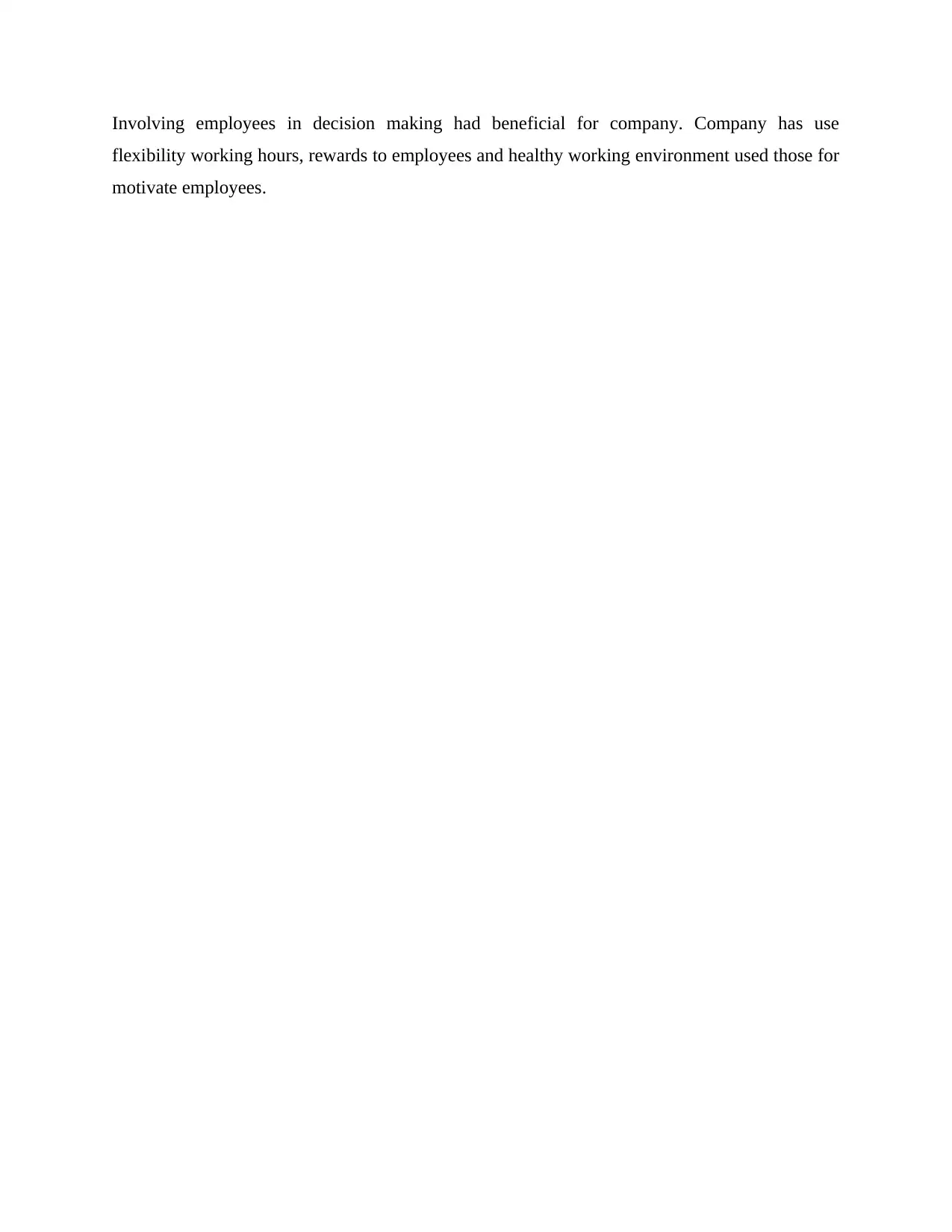
Involving employees in decision making had beneficial for company. Company has use
flexibility working hours, rewards to employees and healthy working environment used those for
motivate employees.
flexibility working hours, rewards to employees and healthy working environment used those for
motivate employees.
⊘ This is a preview!⊘
Do you want full access?
Subscribe today to unlock all pages.

Trusted by 1+ million students worldwide
1 out of 15
Related Documents
Your All-in-One AI-Powered Toolkit for Academic Success.
+13062052269
info@desklib.com
Available 24*7 on WhatsApp / Email
![[object Object]](/_next/static/media/star-bottom.7253800d.svg)
Unlock your academic potential
Copyright © 2020–2025 A2Z Services. All Rights Reserved. Developed and managed by ZUCOL.





